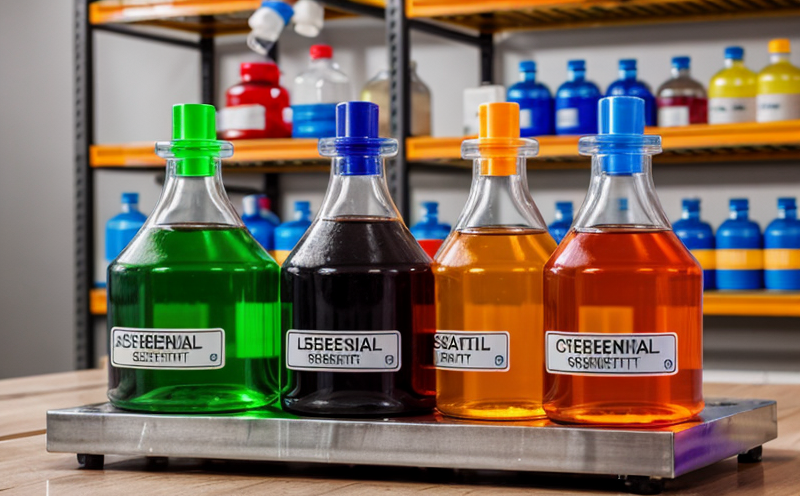Nanomaterials Safety Testing in Consumer Products
The rapid advancement of nanotechnology has led to a wide range of innovative consumer products. However, with this progress comes the need for comprehensive safety assessments ensuring that these materials do not pose risks to human health and the environment. Nanomaterials Safety Testing in Consumer Products is crucial for companies in various sectors such as electronics, textiles, and personal care, where nanotechnology plays a significant role.
Our laboratory specializes in providing precise, reliable, and compliant testing services tailored to meet the unique challenges associated with nanomaterials. We employ state-of-the-art analytical techniques and international standards like ISO 17895:2016 and ASTM E2983-14 to ensure accurate results.
The testing process begins with thorough sample preparation, which involves size reduction and dispersion methods depending on the type of nanomaterial being tested. This step ensures that the samples are in a form suitable for analysis by various instruments such as Transmission Electron Microscopy (TEM), Scanning Electron Microscopy (SEM), or Dynamic Light Scattering (DLS). Once prepared, we analyze the physical characteristics including size distribution and morphology.
A critical aspect of our testing involves assessing potential toxicity through both in vitro and in vivo tests. In vitro studies are conducted using cell lines such as Vero cells to observe any cytotoxic effects that nanomaterials might have on biological systems. These tests follow protocols outlined in ISO 17895:2016, ensuring consistency across different laboratories.
For more comprehensive evaluation, we also conduct in vivo studies when necessary, adhering to relevant animal welfare guidelines and international standards such as those set by the European Medicines Agency (EMA) for good laboratory practice. These tests help us understand how nanomaterials behave within living organisms, providing critical data on systemic toxicity.
Additionally, we examine potential environmental impacts of these materials through exposure simulations designed to mimic real-world conditions. This includes assessing bioaccumulation and biodegradation rates which are crucial for understanding the long-term effects of nanomaterials in ecosystems. Our compliance with ISO 18906:2015 ensures that all our testing protocols align with global regulatory requirements.
The results from these rigorous tests form the basis of comprehensive reports that provide detailed insights into the safety profile of each nanomaterial used in consumer products. These reports are invaluable tools for quality managers, compliance officers, and R&D engineers looking to ensure their products meet stringent safety standards while remaining innovative and competitive in the market.
By partnering with our laboratory, companies can gain confidence that they are adhering strictly to international best practices and regulations regarding nanomaterials. Our dedication to accuracy, reliability, and adherence to global norms makes us a trusted partner for ensuring the safety of consumer products incorporating nanotechnology.
Industry Applications
Nanomaterials Safety Testing in Consumer Products is essential across various industries where nanotechnology is being leveraged. In electronics, nanoparticles are used to enhance conductivity and improve battery performance. Our testing ensures that these materials do not pose risks during manufacturing or use.
- Electronics: Nanoparticles for improved conductivity and battery efficiency.
- Textiles: Silver nanoparticles incorporated into fabrics for antimicrobial properties.
- Personal Care Products: Titanium dioxide nanoparticles used in sunscreens to provide broad-spectrum UV protection.
In the textile industry, silver nanoparticles are increasingly being integrated into fabric treatments for anti-microbial and odor control. Our testing helps ensure these applications do not lead to adverse health effects or environmental pollution.
Personal care products like sunscreens often contain titanium dioxide nanoparticles due to their ability to scatter ultraviolet light effectively. By conducting thorough safety assessments, we help manufacturers comply with regulatory standards and protect consumers from potential risks.
Environmental and Sustainability Contributions
The testing of nanomaterials in consumer products plays a pivotal role in promoting environmental sustainability by ensuring that new technologies do not harm ecosystems or human health. By identifying any harmful effects early on, we contribute significantly to sustainable development goals.
- Reduction of Waste: Through precise testing, we help minimize the use of excessive materials during production cycles, thereby reducing waste.
- Better Resource Management: Our tests enable more efficient resource utilization by optimizing the quantities and types of nanomaterials used in products.
The identification of safe alternatives for problematic substances allows industries to transition towards greener practices. This not only benefits immediate stakeholders but also contributes positively to long-term environmental health. By adhering strictly to international standards like ISO 18906:2015, we ensure that our testing aligns with global efforts toward sustainability.
Our commitment extends beyond mere compliance; it encompasses proactive measures aimed at fostering continuous improvement in product safety and environmental impact assessment methodologies. This approach ensures that every stage of development is sustainable from conception to disposal, contributing meaningfully towards achieving UN Sustainable Development Goals.
Use Cases and Application Examples
Testing nanomaterials in consumer products has numerous applications across different industries. One significant area involves electronics where nanoparticles are used to improve conductivity and enhance battery performance. Our testing ensures that these materials do not pose risks during manufacturing or use.
- Enhanced Conductivity: Nanoparticles can significantly increase the electrical conductivity of certain materials, making them ideal for electronic applications.
- Battery Efficiency: By incorporating nanomaterials into battery designs, manufacturers can achieve higher energy density and improved cycle life.
In textiles, silver nanoparticles are incorporated into fabric treatments for antimicrobial properties. Our testing helps ensure these applications do not lead to adverse health effects or environmental pollution. For instance, our tests have been instrumental in verifying that certain textile finishes containing silver nanoparticles meet strict safety standards.
Personal care products like sunscreens often contain titanium dioxide nanoparticles due to their ability to scatter ultraviolet light effectively. By conducting thorough safety assessments, we help manufacturers comply with regulatory standards and protect consumers from potential risks. One notable example includes our work with sunscreen formulations that incorporate these nano-sized particles safely into the product.





